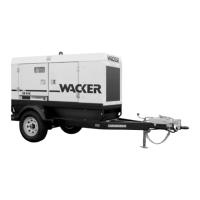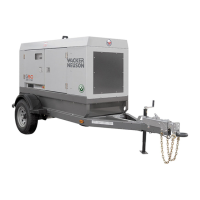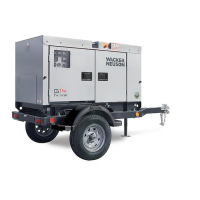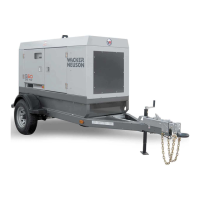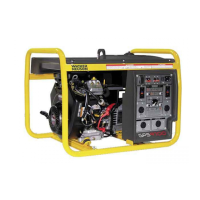1A-3
G2.5A OPERATION 1A
1.2 Operating Safety
Familiarity and proper training are required for the safe operation of electrical equipment! Equipment operated
improperly or by untrained personnel can be dangerous! Read the operating instructions and familiarize yourself with
the location and proper use of all instruments and controls. Inexperienced operators should receive instruction from
someone familiar with the equipment before being allowed to operate the generator.
NEVER operate generator when open containers of
fuel, paint, or other flammable liquids are near.
NEVER operate generator, or tools attached to the
generator, with wet hands.
NEVER use worn electrical cords. Severe electrical
shock and equipment damage may result.
NEVER run generator indoors or in an enclosed area
unless adequate ventilation, through such items as
exhaust fans or hoses, is provided. Exhaust gas from
the engine contains poisonous carbon monoxide gas;
exposure to carbon monoxide can cause loss of
consciousness and may lead to death.
NEVER run electrical cords under the generator, or
over vibrating or hot parts.
NEVER enclose or cover generator when in use or
when hot.
NEVER overload generator. The total amperage of
the tools and equipment attached to the generator
must not exceed the load rating of the generator.
NEVER stand on the machine.
NEVER allow untrained personnel to operate or ser-
vice the generator. Know how to operate and stop
generator before starting it.
NEVER operate generator in snow, rain, or standing
water.
ALWAYS keep generator at least one meter away
from structures, buildings, and other equipment dur-
ing use.
ALWAYS keep generator out of reach of children and
pets.
ALWAYS keep the area immediately surrounding the
generator clean, neat and free of debris.
ALWAYS position and operate generator on a firm,
level surface.
ALWAYS remove all tools, cords, and other loose
items from generator before starting it.
ALWAYS make certain generator is well-grounded
and securely fastened to a good earthen ground.
ALWAYS transport generator in an upright position.
BACKFEED FROM THE GENERATOR INTO THE PUBLIC POWER DISTRIBUTION SYSTEM CAN
CAUSE SERIOUS INJURY OR DEATH TO UTILITY WORKERS!
Improper connection of generator to a building's electrical system can allow electrical current from the generator
to backfeed into utility lines. This may result in electrocution of utility workers, fire, or explosion. Connections to
a building's electrical system must be made by a qualified electrician and comply with all applicable laws and
electrical codes.
If connected to a building's electrical system the generator must meet the power, voltage, and frequency
requirements of the equipment in the building. Differences in power, voltage, and frequency requirements may
exist and improper connection may lead to equipment damage, fire, and personal injury or death.
!
DANGER
WARNING
!

